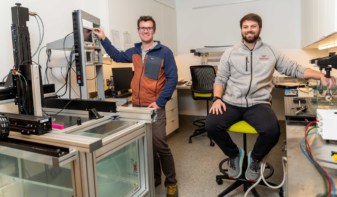
Thermal ablation is a safe, effective treatment for early-stage lung cancer, according to a study from Yale School of Medicine. The results show that ablation may provide an alternative approach for patients who are ineligible for lung cancer surgery (Radiology 10.1148/radiol.2018180979).
Non-small cell lung cancer (NSCLC) accounts for approximately 85% of all lung cancer cases. For early-stage disease, surgery is the treatment of choice. But older patients and those with comorbidities may not be suitable for surgery due to a higher risk of complications. Stereotactic radiotherapy (SRT) is a viable alternative for such patients and can provide high local control rates. Irradiation, however, sometimes harms healthy tissue surrounding the tumour and carries a risk of short-term and long-term toxicities.
Another option is thermal ablation, in which a probe is inserted directly into the tumour under precise image guidance. The tumour is then destroyed via application of extreme heat, extreme cold or radiofrequency (RF) waves.
“Thermal ablation is most often a one-time treatment, unlike SRT, which requires multiple visits,” says senior author Hyun “Kevin” Kim. “In addition, ablation delivers highly accurate and precise localized treatment only to cancer cells, minimizing the effects to surrounding tissue and keeping the toxicity low.”
For the study, Kim led a multidisciplinary team of thoracic oncology investigators in comparing the outcomes of thermal ablation and SRT for treatment of early-stage NSCLC. The study group included almost 29,000 patients from the 2004-2013 National Cancer Database, including more than 1100 who had undergone thermal ablation (cryosurgery, laser ablation or local tissue destruction such as RF ablation).
The researchers performed one-to-one matching of patients, based on their respective propensity to undergo thermal ablation, and obtained a matched cohort of 2140 patients. In this matched cohort, both treatment methods delivered comparable performance in terms of overall survival. The two-year survival rate in the thermal ablation group was 65.2%, compared with 64.5% for the SRT group. At five years, survival rates were 24.6% and 26.1% for thermal ablation and SRT, respectively.
“The outcomes for patients who received thermal ablation for early lung cancer were quite similar to those who received SRT,” says Kim.
The team also examined unplanned hospital readmission within 30 days after treatment, as a surrogate parameter for complications. Readmission rates were higher after thermal ablation than SRT — 3.7% (40 of 1070) versus 0.2% (two of 1070), respectively — possibly due to the more invasive nature of the ablation treatments. The authors note, however, that complications from thermal ablation (mostly pneumothorax) manifest immediately or within a few days, while adverse events after radiotherapy usually occur over a prolonged treatment phase and would not be captured by the 30-day metric.
Other advantages of thermal ablation include direct access to the tumour itself, which enables physicians to collect biopsy samples during the procedure — an option not available with SRT. “This is a real value to our patients, especially as tissue sampling becomes more and more important in personalized, precision cancer treatments,” Kim explains. The one-time treatment also has lower direct costs and could prove a more cost-effective alternative to radiation therapy.
The researchers are now planning further studies of thermal ablation’s potential role in the total care of lung cancer patients. Combining ablation with immunotherapy, for instance, may produce better results than those of ablation or immunotherapy alone.



